A Night under the Stars - Kantegaon Lake
Milky Way Photography, Meteor Photography & Timelapses from light polluted areas
Kantegaon Lake, Boath Buzurg, Telangana, India
When you think of photographing the Milky Way, you usually think of doing it from a dark location away from light pollution but given the way modern cities have expanded it isn’t always possible to find a dark location close to any major city especially in India. There is no substitute for a truly dark sky, but I knew it was possible to photograph the Milky Way through light pollution provided one went far enough away from the capital city of Hyderabad. Hyderabad itself is a Bortle 8-9 sky as you can see in the light pollution map below but that’s not the end - South India itself is very limited in terms of dark skies. Read more about the Bortle Scale.
As part of an initiative led by the Telangana State Forest Department and the Boath Nature Conservation Society, I was able to explore some of the wilderness and wetland habitats around the quaint village of Boath. With their help and support I spent a night camping at the Kantegaon Lake photographing the night sky and evaluating the possibility of Milky Way and Astrophotography at the location. This was also during the time of the Leonid Meteor shower and through the night I was able to capture 5-6 meteors and saw quite a few more away from the camera.
Kantegaon Lake is an important water body in the Boath Buzurg area of Telangana, significant for its ecological role and its proximity to areas rich in tribal culture. While specific historical details about the lake itself are limited in available records, the surrounding Boath Buzurg region has a long history intertwined with the lives of prominent tribal communities, particularly the Gonds and Kolams. During the night I was honoured to be in the company of several members of the Rajgond tribe, now working with the Forest Department, who sang several Gondi songs describing nature and its nuances. The song you hear in the timelapse is one such lore.
The following gallery is of the meteors seen through the night. These are individual photos of a timelapse I ran through the night to daylight to capture as much of the night sky as possible. What you see in the video is the time between 2030hrs on 13th November and 0545hrs on 14th November 2025. All of these are also listed in the video at the end with the meteors marked.
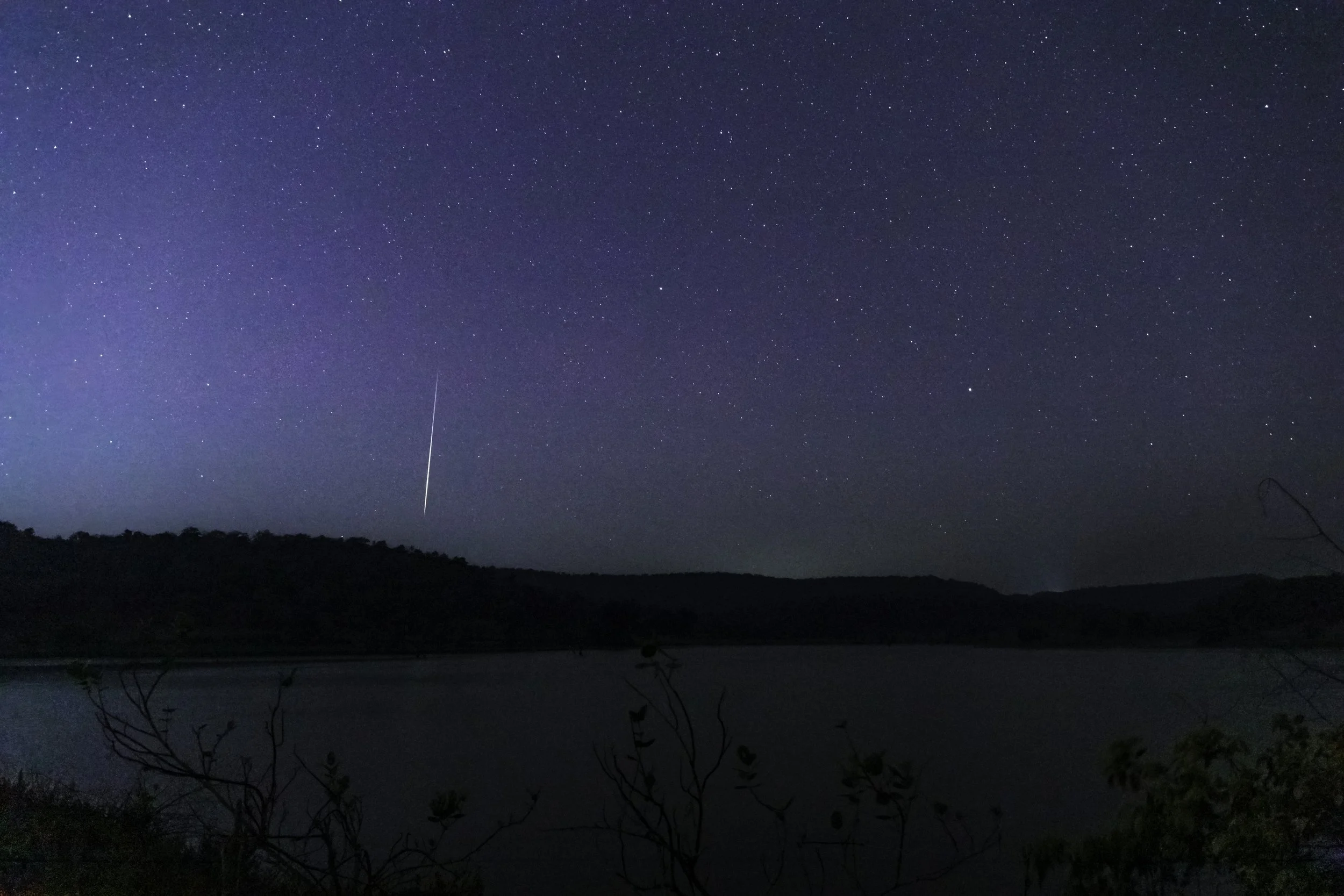

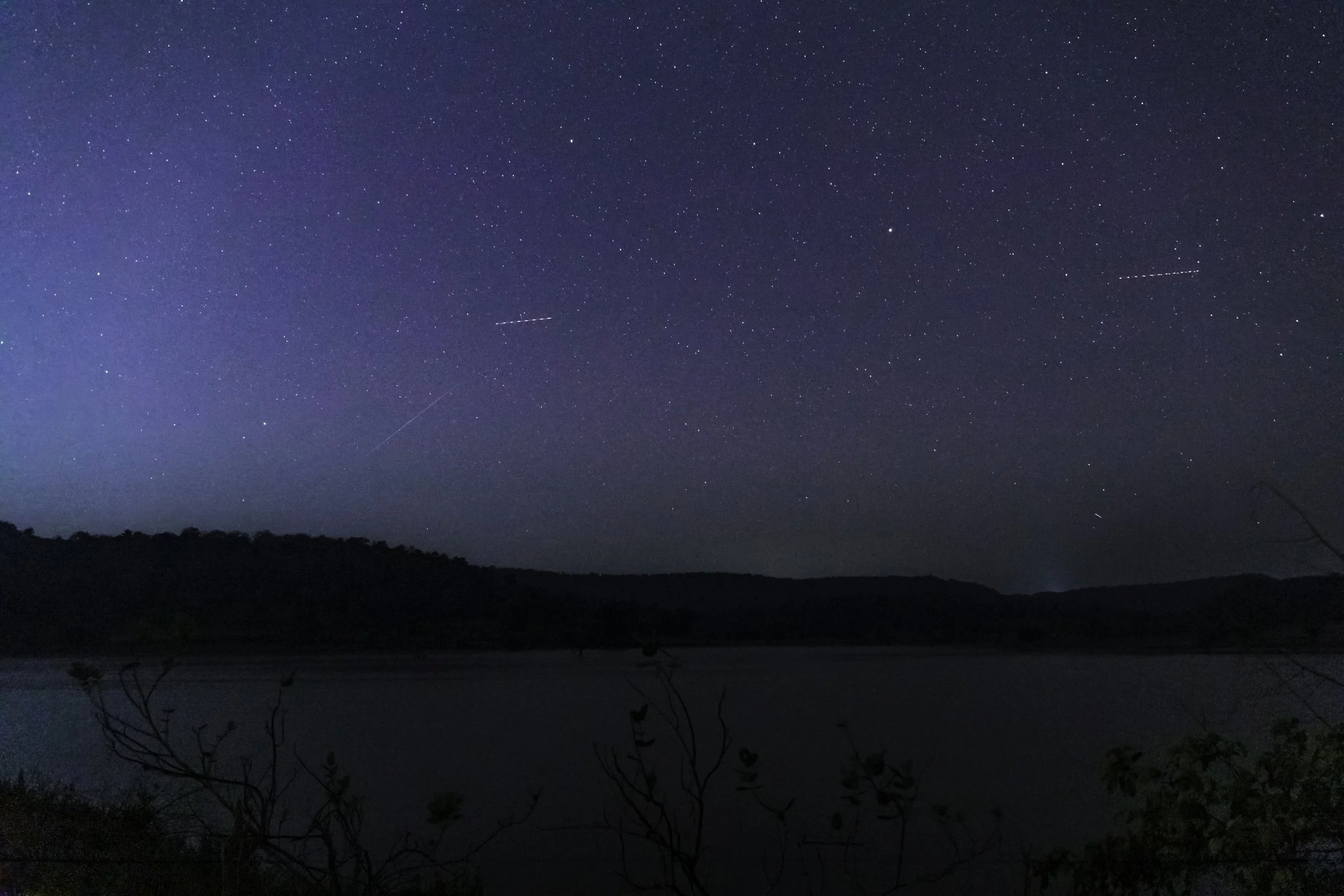


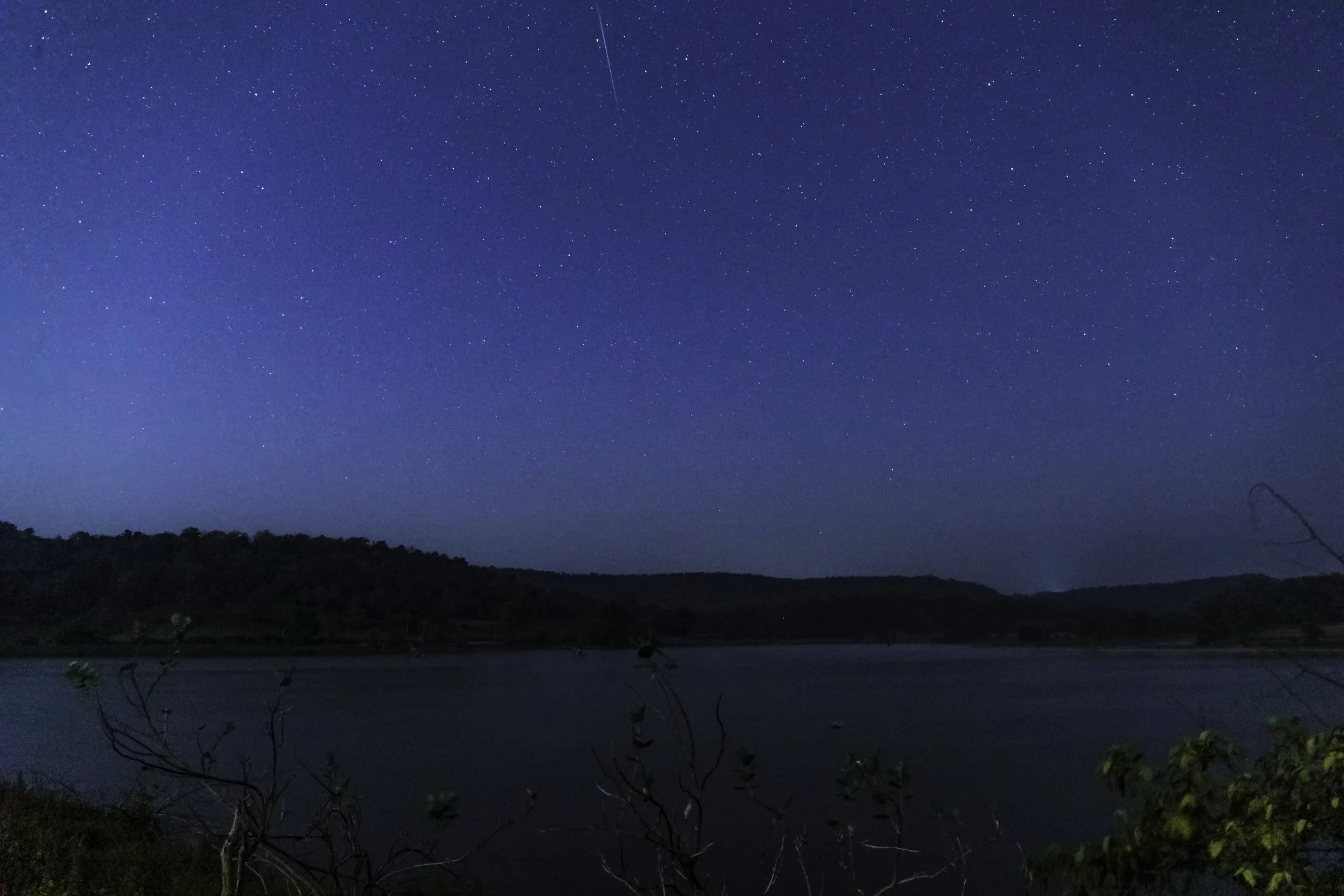
The Leonid Meteor Shower
The Leonid meteor shower is an annual celestial event that occurs when Earth passes through the trail of dust and debris left by the periodic Comet 55P/Tempel-Tuttle. Known for its exceptionally fast and bright meteors, the shower is famous for occasionally producing spectacular "meteor storms".
Key Characteristics
Parent Body: The short-period comet 55P/Tempel-Tuttle, which orbits the Sun approximately every 33 years. It will visit again in 2031.
Speed: Leonid meteors are some of the fastest, entering the Earth's atmosphere at speeds of up to 71 kilometers per second.
Appearance: Their high velocity often produces bright, fast streaks of light and "fireballs" (very bright meteors), which can leave glowing vapor trails that linger for several seconds or minutes. They can also display vibrant colors, including blue, green, and yellow. The last meteor in my timelapse - the last photo in the gallery above - clearly shows green.
Radiant: The meteors appear to originate from a point (the "radiant") within the constellation Leo (the Lion), specifically near the "Sickle" asterism, giving the shower its name.
While in most years the Leonids produce a modest rate of about 10-15 meteors per hour, the shower is historically famous for powerful meteor storms. These storms, which can feature thousands of meteors per hour, tend to occur roughly every 33 years, coinciding with the comet's closest approach to the Sun (perihelion). Notable past storms include:
1833: An estimated 100,000 or more meteors per hour, inspiring widespread awe and fear across North America.
1966: Observers in the U.S. witnessed thousands of meteors per minute for a brief period, an experience described as meteors falling like rain.
2001/2002: More recent storms produced several thousand meteors per hour.
The next potential for a significant outburst is anticipated around 2031, following the comet's next return to the inner solar system.
The Leonids are an annual November event, with peak viewing typically occurring in the pre-dawn hours when the constellation Leo is high in the sky. For the best observation experience, please try to find a dark location far away from city lights, allow eyes to adjust for at least 30 minutes, and look up at the entire sky (not just the radiant). No special equipment like telescopes or binoculars is needed.
For the Timelapse I used my trusty Canon 1Dx Mark ii paired with the EF 24-70mm f/4L IS USM | f/4 @24mm. The camera was perched on my ever reliable ProMediaGear sticks and I have not used any Night or Light Pollution filters.
Exif: Canon 1Dx Mark ii | EF 24-70mm f/4L IS USM | f/4 @24mm | 11 seconds | ISO 4000 | Manually focused with a Bahtinov Mask & WB set to Manual at 3800k.
Timelapse Start: 20:39:25 | Timelapse End: 05:44:26 | Total Duration of shoot: ~ 9 hours 5 minutes. 6 separate meteors from the Leonid Meteor Shower were captured throughout the night.
Audio Recording Equipment: Zoom H1N and an iPhone. All the audio you hear within the timelapse is recorded at the site as the timelapse was being shot.
The song - a Gondi folksong - was performed by a few members of the Forest Department most of whom were Rajgonds. It is about a bird trying to protect its eggs.
For sharing their lore with me I am grateful to FRO Mr. Pranay Thodishetty, FBO’s Kodapa Nagorao & Jadhav Anil Kumar and Trackers - Godam Ramakrishna, Athram Anilkumar, Athram Shambhu, Madavi Bheemrao, Rathod Sandeep, Ade Rajendar - and for singing me their songs through the night. నా కృతజ్ఞతాపూర్వక ధన్యవాదాలు.
Find everything I have used in my Kit Bag.
Kantegaon Lake
Kantegaon Lake plays a vital role in the local ecosystem, though specific details on its construction (unlike the well-documented Kakatiya-era Laknavaram and Hussain Sagar lakes) are not widely available in public records. It is located in the Adilabad district, an area characterized by hilly and forested regions. Lakes and tanks have historically been crucial in the semi-arid Deccan region for supporting settled agriculture and local livelihoods, and Kantegaon likely serves a similar function for nearby communities. The area around Boath includes numerous villages and is part of a region with a significant tribal population, which makes up over 31% of the Adilabad district's population. They are also blessed with a number of stunning waterfalls which I will detail in following blogs and videos.
The history of the broader region traces back through various powerful South Indian dynasties:
Ancient Period: The region was part of the southernmost extent of the Mauryan Emperor Asoka's kingdom around 250 BC and later came under the rule of the Satavahana dynasty (221 BC - 218 AD).
Medieval Era: Subsequent rulers included the Chalukyas, Rashtrakutas, and the Kakatiya dynasty, the latter of whom were known for their advanced water management systems, building numerous tanks and lakes across Telangana. An excellent example is the Bansilalpet Stepwell. There are over 800 such wells across the state of Telangana.
Post-Medieval & Modern: The area was later part of the Bahamani, Qutub Shahi, and Mughal empires and eventually became a part of the Nizam's dominion (the Hyderabad State). After India's independence, it was part of Andhra Pradesh until the formation of the new state of Telangana in 2014.
The Tribal Communities of the Area
The Boath Buzurg area and the wider Adilabad district are home to several aboriginal tribes who have coexisted with the environment for centuries. The most prominent groups include the Gonds and the Kolams.
The Gonds are one of the largest and most influential tribal communities in Telangana, primarily found in the Adilabad, Warangal, Karimnagar, and Khammam districts.
Culture and Traditions: Gonds have a rich cultural legacy, distinct language (Gondi), and are known for their beautiful art, music, and dance.
Livelihood: Traditionally, the Gonds practiced shifting cultivation and hunting-gathering, but many have transitioned to settled agriculture, growing crops like cotton, jowar, and pulses.
Social Structure: Gond social life is connected to animistic religious beliefs and ancestral worship. Disputes are typically settled by village councils headed by a "peddamanishi" (village elder).
A bit about the Rajgonds whose voices and song became an integral part of my timelapse and made it all the more special.
Rajgonds
The Rajgonds, a landholding and ruling class among the Gonds, have a culture centered on nature worship. This leads to an affinity for the environment and contributions to conservation in the Telangana region. Their culture shows their belief in the interconnectedness of all living beings and nature.
Belief System: Their religion, Koyapunem, is animistic. It reveres gods and goddesses (“Mahadeve” or “Badadev”) who represent natural features like earth, sky, air, fire, and water (భూమి, గగన్, వాయు, అగ్ని, నీర్). They worship ancestral spirits, natural objects, animals, and plants, believing everything in nature has a soul.
Art and Expression: Gond art illustrates their connection to the environment. Paintings often depict animals (peacocks, chameleons, fish, elephants) and plants using natural pigments from flowers, leaves, minerals, and soil.
Songs and Oral Traditions: Their folklore is passed down through songs and stories. These traditions, often performed by the Pardhan community (bards for the Gonds), tell of family lineage, spirituality, the Gond creation myth, and the importance of their surroundings.
Sua Dance: Women perform this dance during harvest, accompanied by songs that praise the parrot and peacock, symbolizing fertility and nature's bounty.
Harvest Songs: These songs express gratitude to the earth and invoke the spirits of rivers and trees, reinforcing their ecological consciousness.
Gussadi Dance: A folk dance performed during festivals like Diwali, for which a Rajgond, Kanaka Raju, received a Padma Shri award for popularizing.
Conservation Efforts with the Telangana Forest Department
The Gonds' traditional knowledge and respect for nature have made them key in modern conservation.
Traditional Practices: They establish sacred groves and sacred ponds along rivers where resource extraction or fishing is prohibited, acting as natural conservation zones. Certain plants and animals have religious importance, regulating sustainable harvesting.
Community-Led Initiatives: In Gond villages, the Gram Sabha (village council) makes decisions about forest management and conservation. Villagers organize patrols to stop illegal tree felling and document local biodiversity through "People's Biodiversity Registers". One such organisation is the Boath Nature Conservation Society formed by the local residents of Boath in collaboration with the Telangana State Forest Department. Society members are actively involved in conservation efforts, protection activities and documentation of the wildlife present in their forests.
Collaboration with the Forest Department: The Telangana Forest Department works with tribal communities on several fronts:
Ecotourism and Livelihoods: Local tribal youth work as ecotourism guides, with training in hospitality and ecotourism management. This connects conservation with livelihood, ensuring communities benefit from protecting their environment.
Awareness Programs: Programs like "Jal Jungle Yatra" involve forest staff trekking with villagers to teach them about forests and wildlife.
Community Involvement: The government of Telangana acknowledges the role of tribal communities in providing a cultural ecosystem and integrating their needs with the objective of enhancing green cover. The department has worked with communities to form Biodiversity Management Committees to conserve local wetlands and promote sustainable ecotourism.
This collaboration uses the Rajgonds' connection to “Jal, Jungle, and Jameen” (water, forest, and land) to foster a sustainable approach to conservation in the region
The Kolams are a smaller, but influential, Particularly Vulnerable Tribal Group (PVTG) in Telangana, largely concentrated in the Adilabad and Khammam districts.
Culture and Livelihood: They speak the Kolami language (a Dravidian language) and traditionally engaged in hunting, gathering, and shifting cultivation.
Current Status: Like other tribal communities, the Kolams have faced challenges due to land acquisition and displacement and have also largely shifted to settled farming practices over time.
These communities share a deep, symbiotic relationship with their natural surroundings, and bodies of water like Kantegaon Lake are integral to their lives, supporting their agricultural practices and daily needs. Efforts are continually made by government and non-governmental organizations to support these communities and preserve their unique cultural identities.
The following gallery showcases the beauty of the Lake and its surroundings.
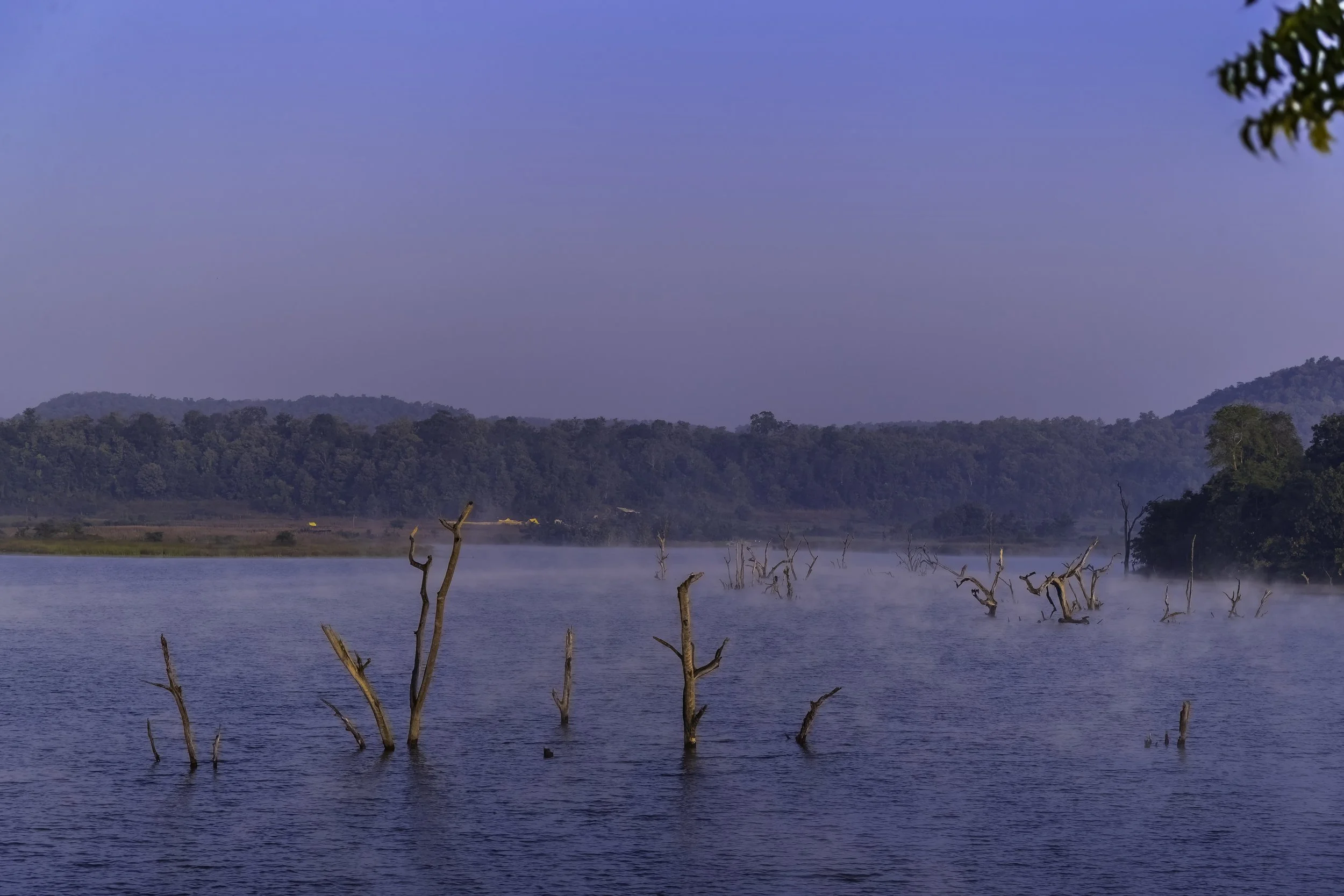

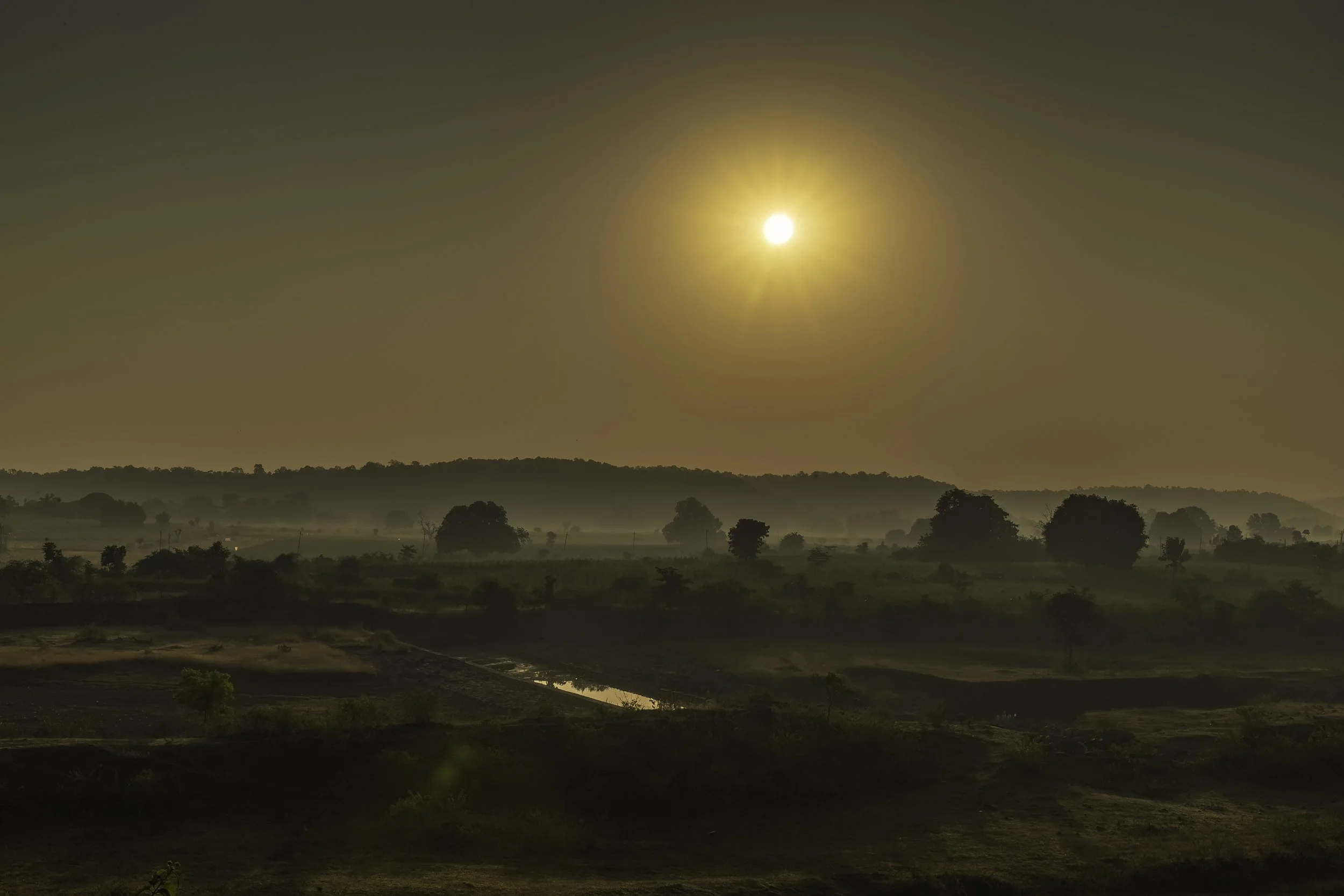
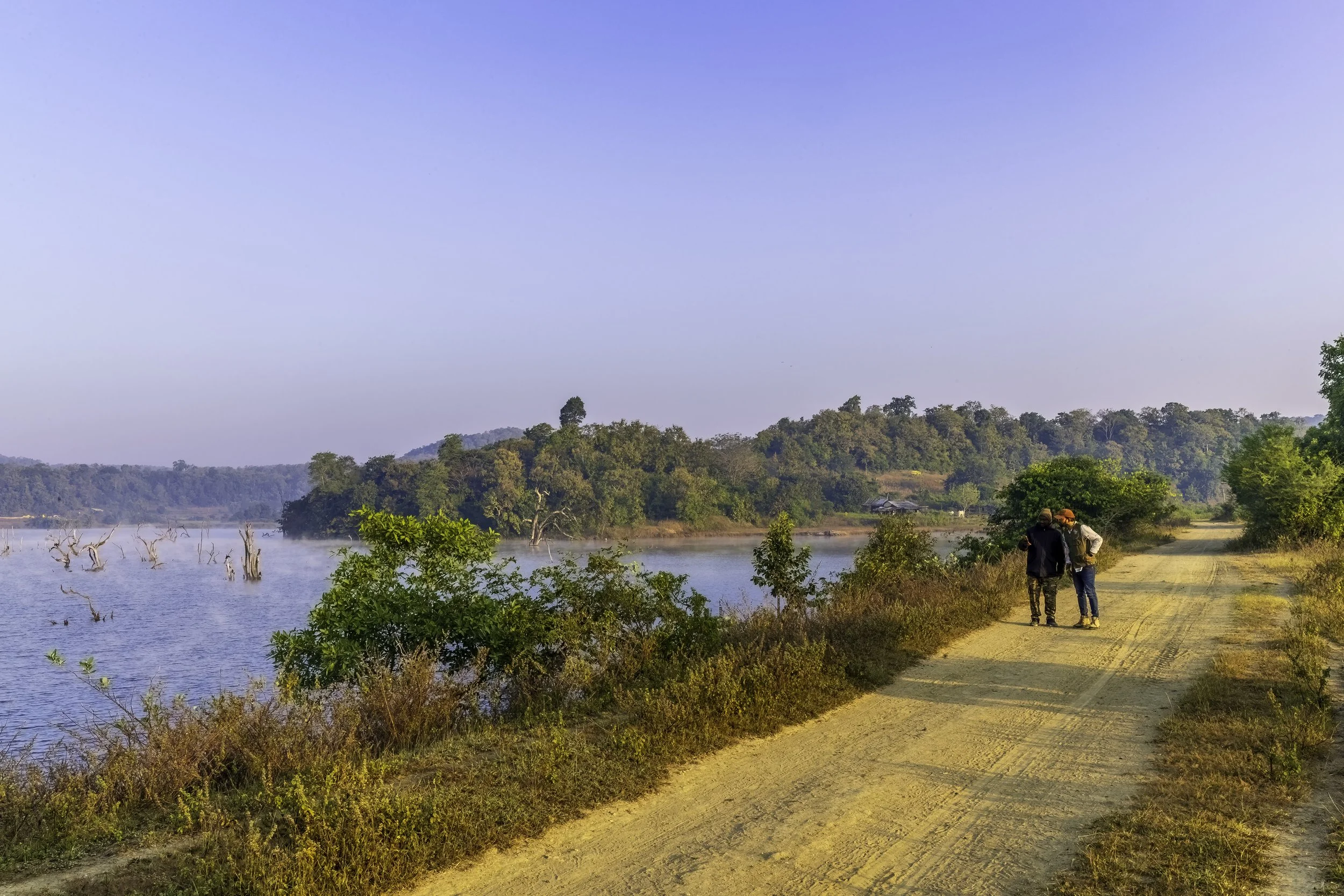


Wild and Birdlife around the lake
Lakes and wetlands in the Adilabad district, such as the Kantegaon Lake near Boath, are vital habitats for numerous bird species. The range of birds includes large water birds and smaller, vibrant species. These lakes play host to numerous waterfowl and waders like the Lesser Whistling-Duck, Indian Spot-billed Duck, Cotton Pygmy Goose, Northern Shoveler, Eurasian Wigeon, Garganey, Indian Pond-Heron, Little Egret, Gray Heron, Painted Stork, Asian Openbill, Woolly-necked Stork, Black-headed Ibis, Oriental Darter, Little Cormorant, Common Sandpiper and the Red-wattled Lapwing.
There are also raptors like Shikra, Oriental Honey-buzzard, Short-toed Snake-Eagle, Spotted Owlet, and Indian Eagle-owl along with the resident birds like the White-throated Kingfisher, Asian Green Bee-eater, Indian Roller (the state bird of Telangana), Indian Grey Hornbill, Alexandrine Parakeet, Red-vented Bulbul, Common Tailorbird, Purple Sunbird, Baya Weaver, Indian Robin, and various flycatchers, warblers, and munias.
The surrounding forests and grasslands are home to a diverse array of animal life, often observed in or around the Kantegaon Lake. These include Spotted Deer (Chital), Sambhar, Indian Bison (Gaur), Nilgai, Blackbuck, Chousingha (Four-horned Antelope), Barking deer, Wild Boar and Indian Porcupine. Among carnivores there are Tiger (though sightings are rare), Leopard, Wild Dog (Dhole), Sloth bear, Jungle Cat, Indian Fox, Jackal, Hanuman Langur and Rhesus Macaque.
There are reptiles like Freshwater turtles, Indian Python, Monitor Lizard, Indian Chameleon, and various venomous snakes like the Indian Cobra, Common Krait, and Russell's Viper and numerous species of butterflies, moths, beetles, and other insects also thrive in the area.







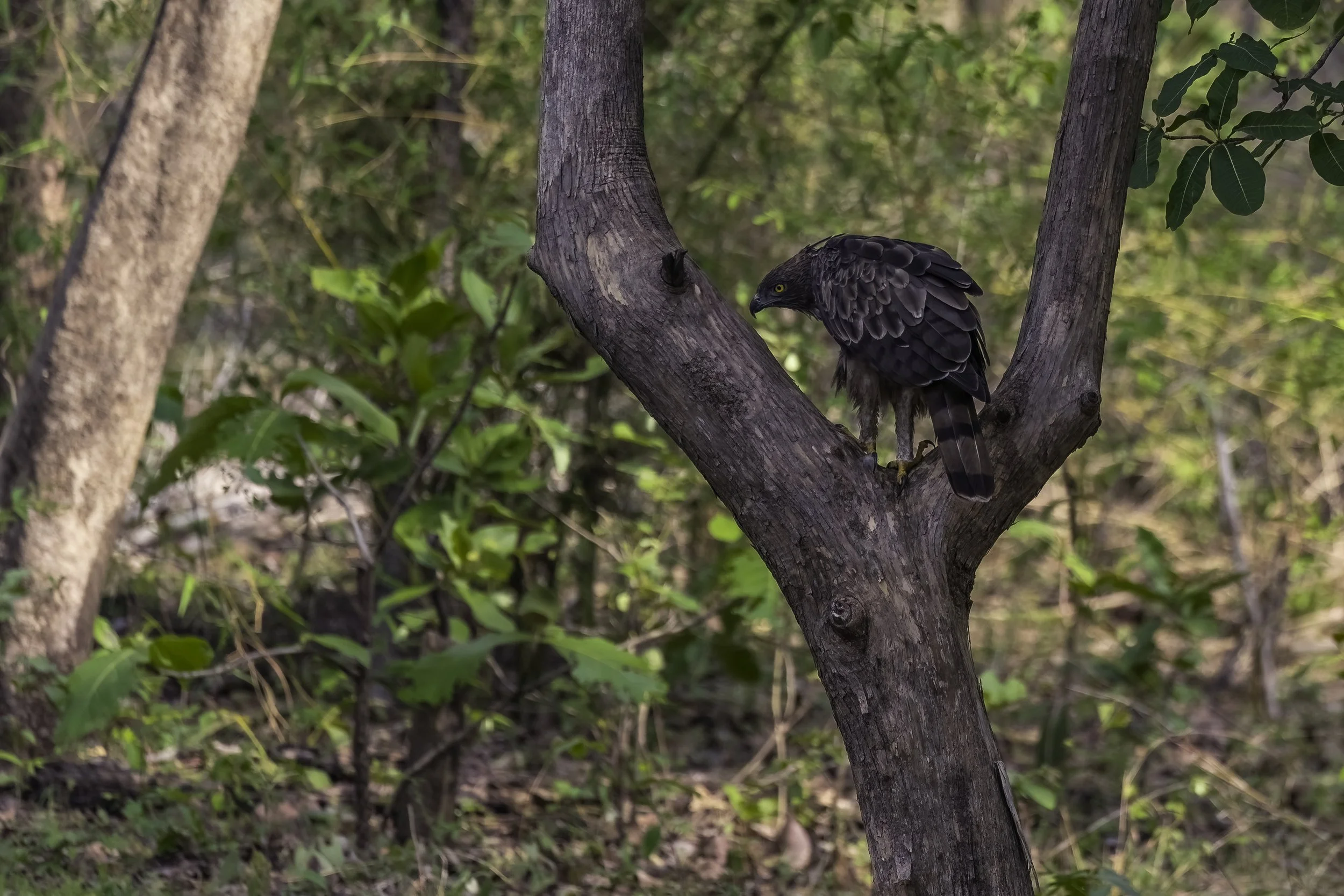
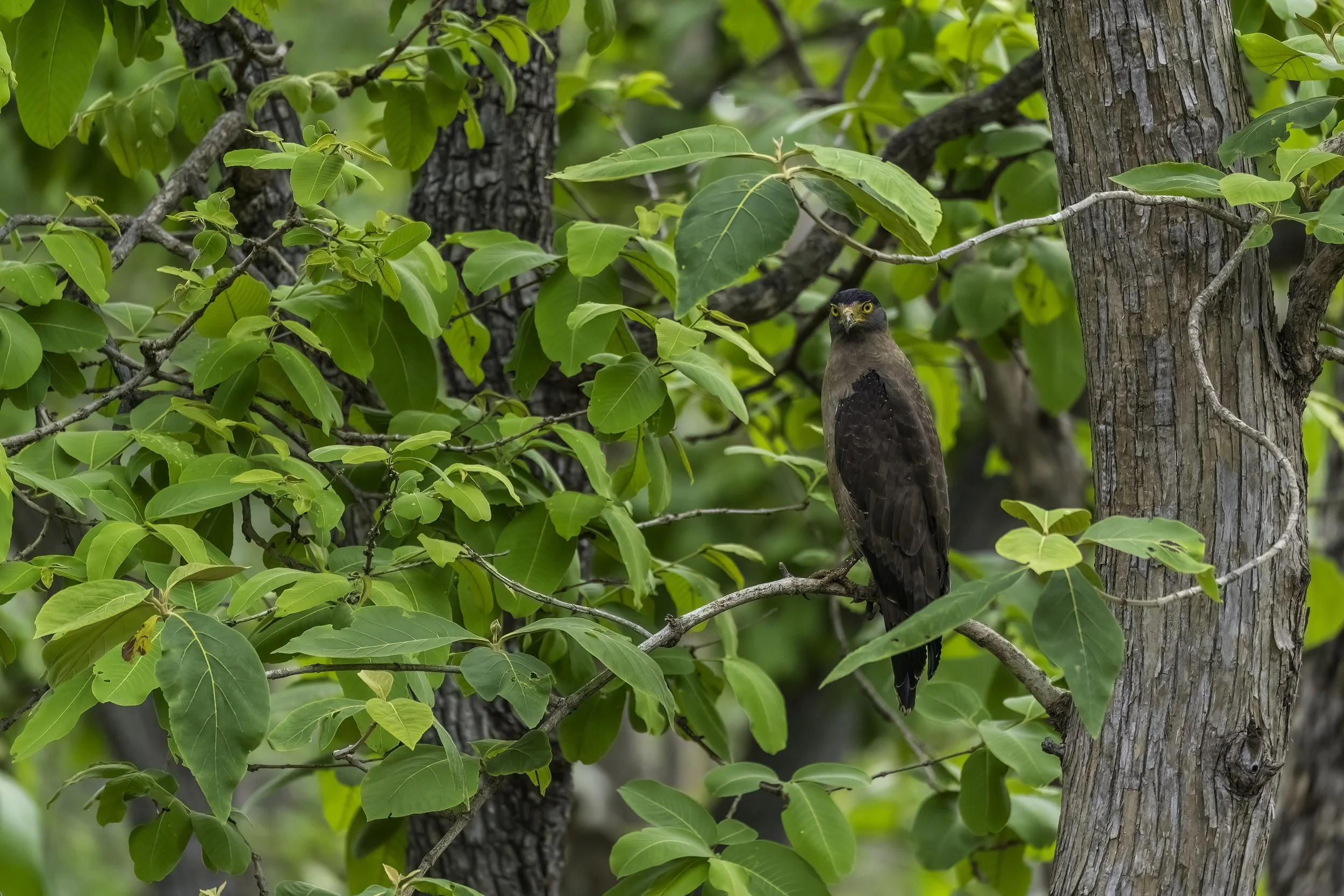
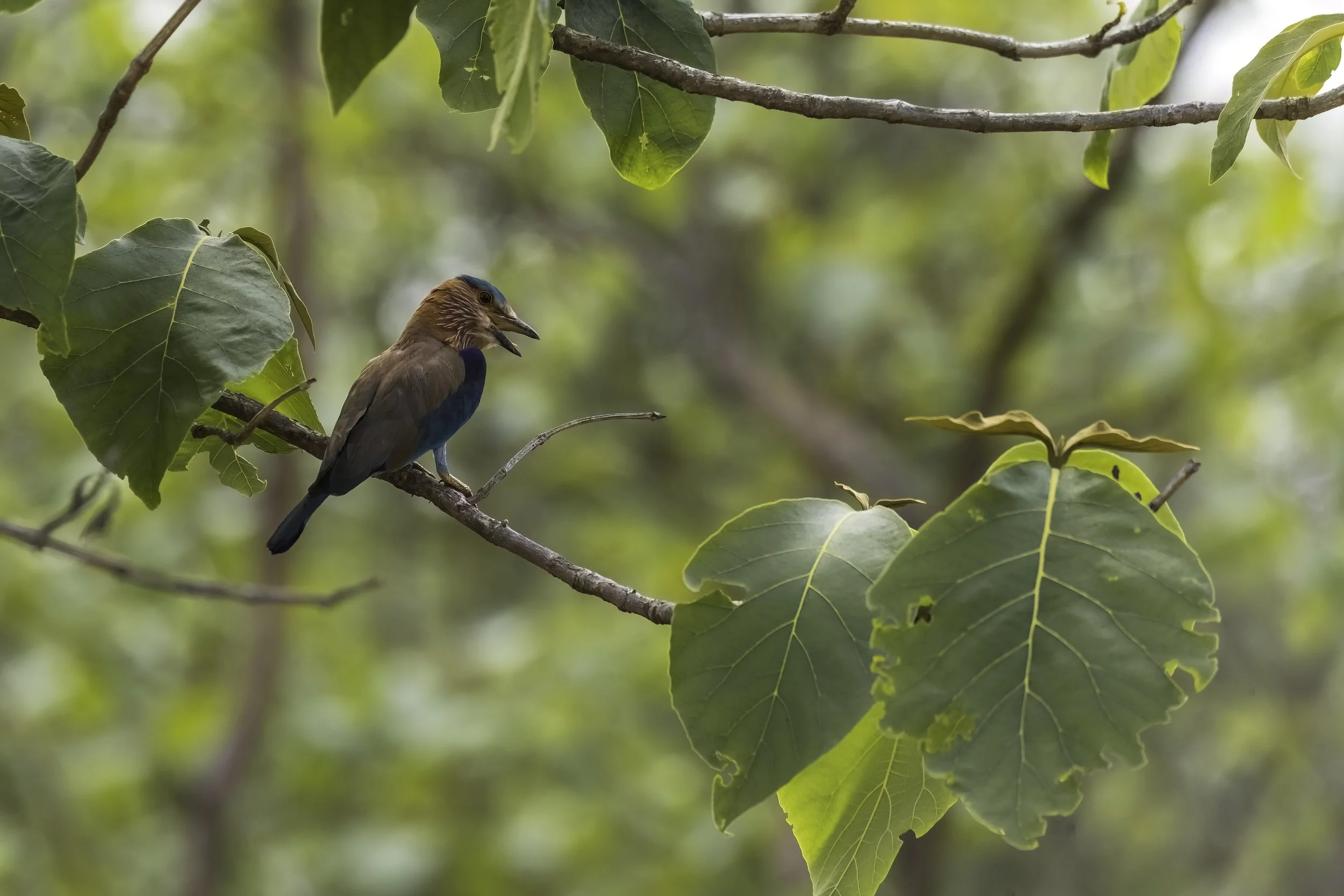

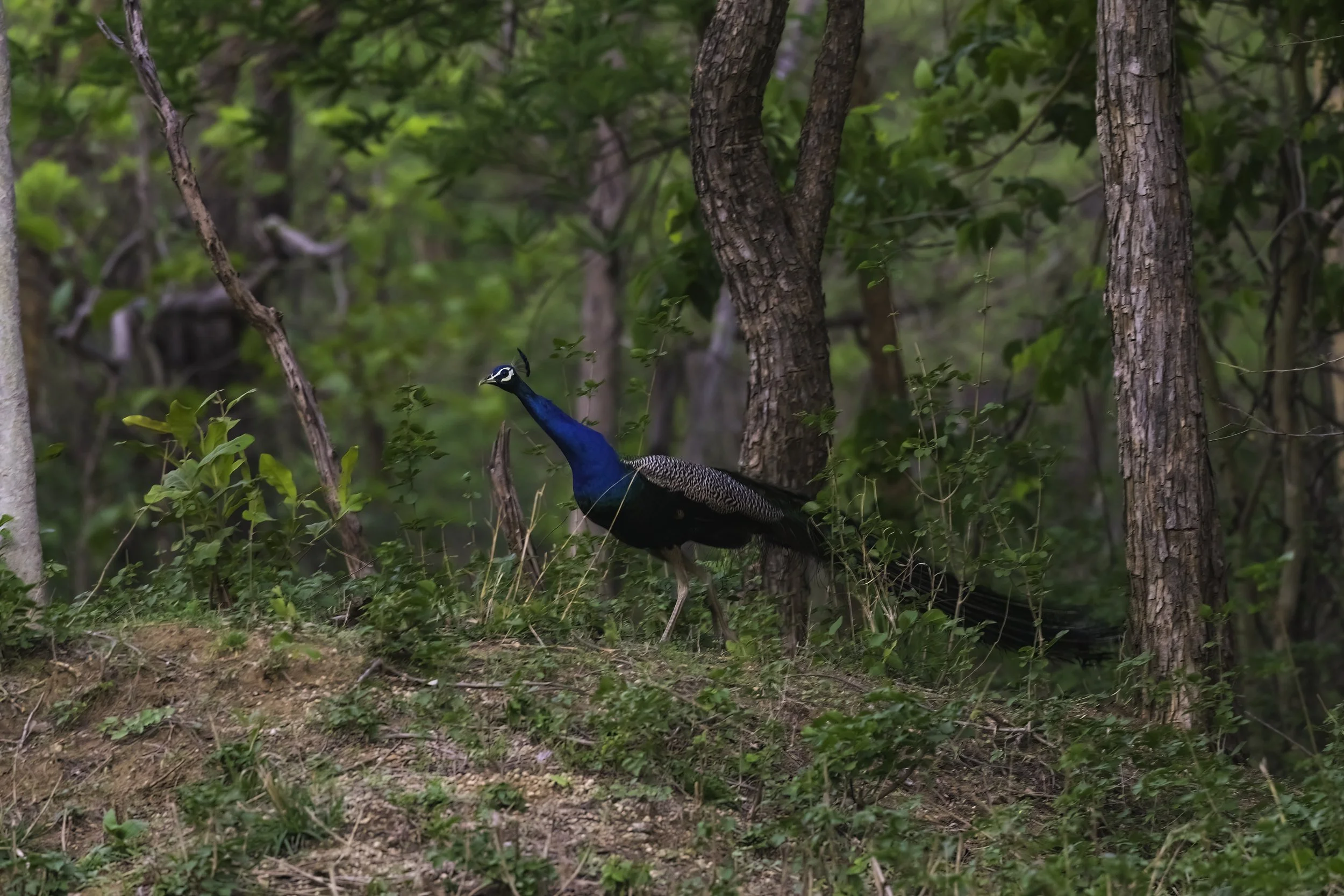


Now getting back to the night sky of this lake. Generally speaking, the best time to see the Milky Way in the Northern Hemisphere is during the Milky Way season - usually between February and October - ideally between 00:00 hrs and 05:00 hrs, preferably on new moon nights. This, however, will vary depending on the latitude, and other factors like the moon phase, prevalent cloud cover and the intrusive presence of light pollution. The position of the Milky Way in the sky is also another important factor to consider and this changes depending on the location.
Just as winter ends and spring begins the Milky Way's core, or the brightest part of our galaxy, becomes visible in the early morning sky, rising in the southeast and moving south - which is the time of this timelapse - reaching peak visibility in the middle of summer. At the beginning of this timelapse, facing south, the outer arm of the Milky Way can be observed setting. Here we are facing away from the galactic center in Sagittarius and instead looking outward. Stars thin out across the galaxy's flattened disk until our gaze meets the abyss of intergalactic space. This section isn't particularly wide, but is strewn with bright stars and chock-a-block with clumpy star clouds, dark nebulae, and well-known naked-eye gems.
As night progresses the stunning Core rises around 3am at this time of the year and at this location. This is also the time when, as the core rises, the Milky Way runs almost parallel to the horizon and I was hoping to get a shot of the entire Milky Way but unfortunately the light pollution did not permit. I have intentionally included - in frame - the light source from a building in the distance as an illustration of how much impact a single LED light source can make on the night sky and its colours. As the sun rises towards the end of the timelapse, the intensity of this light also fades as the sun takes over and we get to realise what it appears to the human eye vs what it does to the night sky. Also note the glow on the left which is from a couple of villages in the near vicinity.
Light pollution has a devastating impact not just on the night sky but on nature as well. As the human population explodes & town and cities grow, light pollution is growing at an alarming rate & is largely going unchecked. Not only is this luminous fog drowning out the stars and our view to the rest of the universe, but it also causes disruptions in circadian rhythms and the balance of ecosystems.
Light Pollution Map Key
A recent study showed that 1/3 of the world’s population will never see the Milky Way with their naked eye. According to available studies, around 70% of India’s population is estimated to live under light polluted skies, meaning the night sky is obscured by artificial light with the major cities experiencing particularly high levels of light pollution.
But just over a hundred years ago everybody could see the Milky Way from the comfort of their own homes and gardens.
The new LED lights are a mixture of Blue, Green and Red, and its the blue that is causing a huge problem. Our atmosphere scatters blue light far more easily than any other colour. It is the reason our skies are blue in the daytime - because the blue light from the sun is being scattered. So even though the LED’s use less energy they are far more light polluting than any other light form. Even using filters will not help because if you filter out the Blue, Green and Red from the LED you are left with none of the primary colours that make up nature.
Light pollution is impacting wildlife, especially the predators of the night, it is impacting humans and their sleep patterns & hormonal patterns. We have a responsibility to protect our wildlife and protect our own health and cutting down on light pollution is not just good for wildlife and humans but it makes good economic sense too as we owe a lot to our night skies. Everything you see and hear in my timelapse is recorded on site.
I have also included all the exif information with each section.
Light Pollution Map of Hyderabad, India
Light Pollution Map of Boath Buzurg, Telangana
Light Pollution Map of South India
Moon Phase on the night of 13-14 November 2025
The 40% Last Quarter Moon on 13-14 November 2025. This wasn’t a problem as the moon was going to rise at 01:22 hrs and would only help to light up the foreground.
Creating a Milky Way Timelapse
Timelapses of the Milky Way are a timeless way to capture the natural beauty of our galaxy as it moves across the sky. It helps provide a real sense of how large and beautiful the band looks as it crosses the night sky in video format. As we all know, the Milky Way is a barred spiral galaxy, it is a large object but is not as big as the closest galaxy to us (which, incidentally, is on a collision path with the Milky Way): the Andromeda Galaxy. We, as part of the Solar System, are at about half the distance from the center of the Milky Way galaxy to its outer edges. We are located in a smaller spiral arm – the Orion Arm – between two large arms. Read more.
But first things first, what exactly is a time-lapse? It is a technique that allows us to take a series of photos and put them together sequentially to create a video. The frames are taken with the same settings over an extended period of time and when put together show movement from the same perspective in a sped-up fashion. Basically speeding up the passage of time - Time Travel!
Timelapses can be created using almost any camera and off late most recent DSLR/mirrorless cameras have a "time-lapse mode" which allows one to create a time-lapse very easily without any editing. Once activated, one just has to point the camera to the the Milky Way, focus, and launch! Me - I prefer the old fashioned way because it gives me more control and especially over the flicker.
There are some additional pieces of gear required
A wide angle lens which will give a nice wide field of view of the Milky Way.
An intervalometer which will help to control the intervals and exposure times. Some modern cameras have built-in intervalometers but I think an external one still provides more flexibility.
A sturdy tripod which is self explanatory as you need a stable base and avoid any shake caused by wind or uneven ground.
A Ball Head to get to the angle required.
Finally a star tracker which will allow to create a Timelapse that follows the Milky Way and will show the rotation of the earth. This, however, is not mandatory but a good to have.
Pro Tip: Do not head north for a Milky Way time-lapse, instead, find a spot that is south of any major city. Why? Orientation matters - especially in India. The Milky Way will pan across the southern half of the sky. Also, avoid light pollution caused by bright cities to the south and east that create light domes. The light glow you see in my photo on the left are from some villages which have been inundated by LED lights - the bane of astrophotography. Why?
The LED lights especially those used for street lighting are INTENSELY bright, much more so than the “old-fashioned” sodiums. Looking up is like staring into the sun. If you have the opportunity, step under an orange sodium street light and then under an LED. You’ll be amazed at the difference in light intensity. Some time back, on a similar Milky Way hunt in Malaysia, to gauge the approximate difference in brightness between the two, I had pulled out my camera and taken a light meter reading on the pavement beneath an LED lamp and then under a high-pressure sodium lamp. The LED was brighter by more than one camera “stop” or more than twice as bright.
Another issue with LED ornamental and street lighting has to do with color. Although natural color LED lighting is available, high-efficiency LED lights emit a much bluer light than sodium vapor. Blue-rich light not only increases the amount of glare sensed by the human eye but also the amount of visible light pollution. Other effects of light trespass and glare include sleeping problems and even an increased risk for certain cancers. From an astrophotography perspective this LED glow is almost impossible to eliminate and believe me I have tried all the night filters available including dedicated narrowband Astro filters. Read about them here - Astrophotography Filters.
We humans need the night more than we know.
LEDs are only part of the problem of course. The real issue is the ever-increasing amount of light pollution worldwide and the potential for new LEDs to make it worse. True, we can take advantage of the ability to adjust and dim current lighting to more suitable levels. LEDs are also highly directional, making it easy to point them just where they’re needed. Finally, new high-efficiency more natural (less blue) LEDs are now available that can help reduce light pollution. There’s no question that LED lighting can be used wisely to make everyone happy – stargazers, drivers, shoppers and walkers. For help and more information, the International Dark-Sky Association (IDA) is a great place to start.
Milky Way timelapses don’t need as much control as a day to night time-lapse. In day to night time-lapses, one will have to change the exposure so that the photos look consistent. Fortunately the light tends to be the same in Milky Way photography, so you don’t need to be as alert. The one thing that may get in the way is bad weather, though. Bad weather can make any shoot uncomfortable. It can force one to change the settings or even move the equipment resulting in shaky and unevenly exposed pictures.
The Milky-Way is stunning! It’s the perfect subject for nighttime time-lapse photography. When you take pictures, pay careful attention to the camera settings and don’t be afraid of high ISO numbers. You can experiment with a slow shutter speed if you want to create a star trail time-lapse. You can also elevate your Milky Way time-lapse photography by using special tools like motorised camera sliders. But most of all, enjoy the time under the stars!
The silent & devastating impact of Light Pollution and solutions to mitigate it
Most environmental pollution on Earth comes from humans and their inventions. Take, for example, the automobile or that miraculous human-made material, plastic. Today, automobile emissions are a major source of air pollution contributing to climate change, and plastics fill our ocean, creating a significant health hazard to marine animals.
And what about the electric lightbulb, thought to be one of the greatest human inventions of all time? Electric light can be a beautiful thing, guiding us home when the sun goes down, keeping us safe and making our homes cozy and bright. However, like carbon dioxide emissions and plastic, too much of a good thing has started to negatively impact the environment. Light pollution, the excessive or inappropriate use of outdoor artificial light, is affecting human health, wildlife behavior, and our ability to observe stars and other celestial objects.
Every day needs a night and all around us, this unintended pollutant is taking a silent toll. Each year, thousands of migrating birds and shorebirds are killed because of unnecessary artificial light at night. Light pollution threatens aquatic ecosystems by increasing the risk of harmful algae blooms. It also impacts our circadian rhythms and degrades our quality of life by eradicating our access to the wonder of beautiful night skies.
Light pollution is a global issue. This became glaringly obvious when the World Atlas of Night Sky Brightness, a computer-generated map based on thousands of satellite photos, was published in 2016. Available online for viewing, the atlas shows how and where our globe is lit up at night. Vast areas of North America, Europe, the Middle East, and Asia are glowing with light, while only the most remote regions on Earth (Siberia, the Sahara, and the Amazon) and places like Ladakh in India are in total darkness. Some of the most light-polluted countries in the world are Singapore, Qatar, and Kuwait. According to available studies, around 70% of India’s population is estimated to live under light polluted skies, meaning the night sky is obscured by artificial light with the major cities experiencing particularly high levels of light pollution.
Sky glow is the brightening of the night sky, mostly over urban areas, due to the electric lights of cars, streetlights, offices, factories, outdoor advertising, bright hoardings, and buildings, turning night into day for people who work and play long after sunset. People living in cities with high levels of sky glow have a hard time seeing more than a handful of stars at night. Astronomers are particularly concerned with sky glow pollution as it reduces their ability to view celestial objects. More than 80 percent of the world’s population, and 99 percent of Americans and Europeans, live under sky glow. It sounds pretty, but sky glow caused by anthropogenic activities is one of the most pervasive forms of light pollution.
Time to Wake Up?
Artificial light can wreak havoc on natural body rhythms in both humans and animals. Nocturnal light interrupts sleep and confuses the circadian rhythm — the internal, twenty-four-hour clock that guides day and night activities and affects physiological processes in nearly all living organisms. One of these processes is the production of the hormone melatonin, which is released when it is dark and is inhibited when there is light present. An increased amount of light at night lowers melatonin production, which results in sleep deprivation, fatigue, headaches, stress, anxiety, and other health problems. Recent studies also show a connection between reduced melatonin levels and cancer. In fact, new scientific discoveries about the health effects of artificial light have convinced the American Medical Association (AMA) to support efforts to control light pollution and conduct research on the potential risks of exposure to light at night. Blue light, in particular, has been shown to reduce levels of melatonin in humans. Blue light is found in cell phones and other computer devices, as well as in light-emitting diodes (LEDs), the kinds of bulbs that have become popular at home and in industrial and city lighting due to their low cost and energy efficiency.
Not just humans, Wildlife is impacted as well!
Studies show that light pollution is also impacting animal behaviors, such as migration patterns, wake-sleep habits, and habitat formation. Because of light pollution, sea turtles and birds guided by moonlight during migration get confused, lose their way, and often die. Large numbers of insects, a primary food source for birds and other animals, are drawn to artificial lights and are instantly killed upon contact with light sources. Birds are also affected by this, and many cities have adopted a “Lights Out” program to turn off building lights during bird migration.
A study of blackbirds (Turdus merula) in Germany found that traffic noise and artificial night lighting causes birds in the city to become active earlier than birds in natural areas—waking and singing as much as five hours sooner than their country cousins. Even animals living under the sea may be affected by underwater artificial lighting. One study looked at how marine animals responded to brightly lit panels submerged under water off the coast of Wales. Fewer filter feeding animals, such as the sea squirt and sea bristle, made their homes near the lighted panels. This could mean that the light from oil rigs, passing ships, and harbors is altering marine ecosystems. In Singapore, I have seen common kingfishers become disoriented by the bright city lights of the CBD and crash into the high rises and plummet to their deaths on the pavement below. It was heart breaking to step out of my office at the time and see a kingfisher lying dead on the ground. Even in places meant to provide protected natural habitats for wildlife, light pollution is making an impact. The National Park Service (NPS) has made maintaining a dark night sky a priority. The NPS Night Skies Team has been monitoring night sky brightness in some one hundred parks, and nearly every park showed at least some light pollution.
There are four other kinds of light pollution: GLARE, CLUTTER, LIGHT TRESPASS and SKYGLOW.
Glare – The excessive brightness that can cause discomfort to the eyes.
Clutter – A term used to describe the excessive, bright and confusing groupings of lights.
Light trespass – When light falls where it was not needed or intended.
Skyglow – The brightening of night skies over populated areas
The good news is, the solution is as easy as screwing in a lightbulb. Light pollution is something we can all help erase, in our homes and gardens, the parks that we play in, and the cities and towns we call home. There are several organizations working to reduce light pollution. One of these is the U.S.-based International Dark Sky Association (IDA), formed in 1988 to preserve the natural night sky. IDA educates the public and certifies parks and other places that have worked to reduce their light emissions. In 2017, the IDA approved the first U.S. dark sky reserve. The massive Central Idaho Dark Sky Reserve, which clocks in at 3,667 square kilometers (1,416 square miles), joined eleven other dark sky reserves established around the world. As of December of 2018, IDA lists thirteen dark sky reserves on their site.
Light pollution is reversible!
We can all make a difference. It is not enough to be aware of the problem. You must take action. Everyone who wants to upgrade their outdoor lighting should aim for a minimum energy consumption. Understanding that wasted light is wasted energy supports not only the switch to LEDs, which are more directional than HIDs, but it also means that reducing lighting pollution supports efficiency goals. Lighting energy consumption is reduced even more by integrating controls. There are other factors to consider, especially when artificial lighting is added to the landscape at night.
The night is vital to the earth’s eco-system. Outdoor lighting can be attractive and achieve efficiency goals while providing good visibility. It should also reduce nighttime disturbance.
Things We Can All Do
More people are taking action to reduce light pollution and bring back the natural night sky. Many have adopted legislation to control outdoor lighting, and manufacturers have designed and produced high-efficiency light sources that save energy and reduce light pollution. Individuals are urged to use outdoor lighting only when and where it is needed, to make sure outdoor lights are properly shielded and directing light down instead of up into the sky, and to close window blinds, shades, and curtains at night to keep light inside. Here are some steps we as individuals can take to mitigate Light Pollution.
#1 Turn Off Lights When Not in Use
Many of us are already pre-conditioned to do this when our parents gave us a scolding for leaving the room without turning off the lights. But if you have slowly grown out of the habit, now’s a great time to restart it. Not only does turning off lights help contribute to lessening overall light pollution, it reduces your energy costs at home. LEDs and compact fluorescents (CFLs) can help reduce energy use and protect the environment, but only warm-colored bulbs should be used.
#2 Use Fewer Lights When Inside
Building on #1, it’s just good practice to only use light that you absolutely need. If you appreciate low, ambient lighting, you’re already off to a great start. Having dimmers installed in every room also allows for using less light overall. Dimmers, motion sensors, and timers can help to reduce average illumination levels and save even more energy.
#3 Keep The Curtains Closed At Night
After the sun sets, try to get in the habit of using the curtains or shades to keep room lights from escaping your house or hotel room, as it contributes to the light pollution outdoors. This also allows for your own privacy, especially in close quarters such as in hotel or apartment buildings. Outdoor lighting fixtures that shield the light source to minimize glare and light trespass help prevent light pollution. An illustrated guide to acceptable vs. unacceptable types of light fixtures can be found here. Unnecessary indoor lighting — particularly in empty office buildings at night — should be turned off. This will help prevent leakage of interior light into the night sky.
#4 Avoid Driving at Night
For many, driving at night is like driving in an entirely different world, and some of us have a lack of depth perception, to boot. So unless it’s necessary, avoid driving at night; not only is it safer, using headlights contributes to the degradation of our gorgeous night skies. Especially in India where a substantially large percent of urban drivers use High Beams while driving. Some have even modified the stock lights in their cars to a point where it blinds oncoming traffic and leads to accidents. Some examples you can observe in the timelapse - between 00:47 and 01:13 - specifically at 01:10 when a few vehicles top out on the distant road the high powered headlights are clearly visible and also the extent of their throw from multiple kilometers away.
#5 Turn Off All Lights When Going to Sleep
This goes without saying, but when you’re asleep you don’t need lights! Small night lights to illuminate your way during that midnight bathroom brake are okay, as well as motion sensor lights for safety. The best example is the source of artificial light in my timelapse - the light was on through out the night and into the morning. Incidentally there are street lights which were off and this single light at what I think was a pump house was on almost blanking out the Milky Way itself. This could very easily have been turned off or a motion sensitive low intensity light could have been used.
#6 When Going Outside, Point Your Lights Towards the Ground
When using flashlights or headlights outside to illuminate your way, always try to point them down to the ground. Believe it or not, pointing that tiny ray of light upwards does contribute to light pollution! This is also good practice if you do any night hiking, or night driving whether in the city or in rural areas. This can be observed all through the timelapse.
#7 Use Night Shift Settings on All Devices
Nowadays, with all of our devices such as home computers, laptops, IPads, phones, etc. it has the potential to contribute just as much (or more) to light pollution than regular room lights. Especially when everyone in the family is using them. After dark, the bright lights of our screens are not needed, so switch to a dimmer night setting. It’s also good for our eyes especially since most computer, iPad and phones screens are blue light. Ideally the use of blue lights at night should be avoided:
Outdoor lighting with strong blue content is likely to worsen sky glow because it has a significantly larger geographic reach than lighting consisting of less blue.
Blue-rich white light sources are also known to increase glare and compromise human vision, especially in the aging eye. These lights create potential road safety problems for motorists and pedestrians alike. In natural settings, blue light at night has been shown to adversely affect wildlife behavior and reproduction. This particularly true in cities, which are often stopover points for migratory species.
DarkSky recommends that only warm-appearing light sources be used for outdoor lighting. This includes low-pressure sodium (LPS), high-pressure sodium (HPS), and low-CCT LEDs.
“Warm” toned or filtered LEDs (CCT 3000 K or lower; S/P ratio 1.2 or lower) should be used to minimize blue emission.
#8 Let Your Eyes Adjust to Less Light Instead of Turning on Lights
Sometimes we are used to absentmindedly turning on the lights full blast after the sun sets. But it’s kind of amazing to know that our eyes can adjust rather nicely to no-light or low-light settings if we just give it a few minutes. Don’t believe us? Try it!
#9 Unplug from Devices as the Sun Sets
Going a step further from point number seven, reducing the use of our devices in the evening is always a great habit to form. We’ve all heard of the potential dangers of too much screen time. After dinner, make it a rule to unplug completely. After a few days, you’ll find that it’s pretty easy.
#10 Use Only Downward Facing Lights Inside When You Can
When light points upward it contributes directly to the artificial sky glow – that glow you see over urban and rural areas from a cumulative array of lights. This sky glow spills over into neighboring areas and can also disrupt wildlife. Install light shields for any outdoor lighting set-ups to help direct the light downward to a specific area.
In conclusion, natural darkness should be the default at night – artificial light should be used only for a specific purpose. Remembering that indoor lighting also contributes to light pollution outside, and keeping the above in mind ensures a cleaner and more beautiful night sky for all to enjoy.
Related Posts





